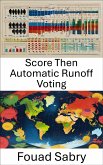What is Approval Voting?
This book explores approval voting systems and their impact on democratic representation, voter satisfaction, and efficiency. It offers a deep dive into the benefits and challenges of using this system in elections.
Chapters Overview
1-Approval Voting-Introduction to the core concepts and principles of approval voting.
2-Score Voting-Compares score voting and its outcomes with approval voting.
3-Condorcet Method-Discusses the Condorcet method and its differences from approval voting.
4-Strategic Voting-Analyzes strategic voting and how approval voting interacts with it.
5-Borda Count-Reviews the Borda count system and its comparative advantages.
6-Condorcet Winner Criterion-Evaluates approval voting against the Condorcet winner criterion.
7-Condorcet Loser Criterion-Investigates how approval voting handles the Condorcet loser criterion.
8-Participation Criterion-Examines approval voting's impact on voter participation.
9-Comparison of Electoral Systems-A detailed comparison of approval voting with other systems.
10-Multiwinner Voting-Explores approval voting's application in multiwinner elections.
11-Two-Round System-Compares the two-round system with approval voting.
12-Bucklin Voting-Introduction to Bucklin voting and its mechanisms.
13-Majority Criterion-Evaluates approval voting against the majority criterion.
14-Nanson's Method-Analyzes Nanson's method and its relevance to approval voting.
15-Later-No-Harm Criterion-Discusses this criterion and its role in voter behavior.
16-Independence of Clones Criterion-Explores the criterion's importance in approval voting.
17-Instant-Runoff Voting-Compares instant-runoff voting with approval voting.
18-Cardinal Voting-Analyzes cardinal voting systems and voter satisfaction.
19-Ranked Voting-Compares ranked voting systems with approval voting.
20-Later-No-Help Criterion-Investigates this criterion in the context of approval voting.
21-STAR Voting-Introduction to STAR voting and its comparison to approval voting.
Who is this book for?
This book is invaluable for students, professionals, and enthusiasts seeking a comprehensive understanding of electoral systems, providing essential insights into the nuances of approval voting.
Dieser Download kann aus rechtlichen Gründen nur mit Rechnungsadresse in A, B, BG, CY, CZ, D, DK, EW, E, FIN, F, GR, H, IRL, I, LT, L, LR, M, NL, PL, P, R, S, SLO, SK ausgeliefert werden.









